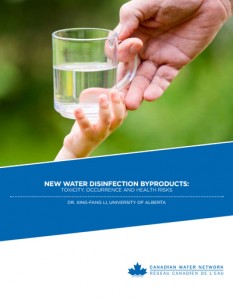Novel Characterization of New Disinfection By-Products and Health Risk
Principal Investigator - Xing-Fang Li, Professor, University of Alberta, 2005 - 2007

Challenge
Drinking water disinfection is essential to reduce microbial infection, but disinfection processes can lead to reactions between disinfectants (such as chlorine) and natural organic matter in the water to form undesirable disinfection bi-products (DBPs). Some DBPs are probable carcinogens (NDMA) and others (halogenated DBPs) may lead to birth defects. Although over 500 DBPs have been reported, the particular DBPs associated with cancer risks and adverse reproductive effects are still unknown, and may not have been identified due to a lack of analytical techniques. In addition, current regulation of THMs has led to changes or additions in the disinfection processes in some water plants. There is serious concern about whether more toxic unregulated and unmonitored DBPs may be produced because of these process changes.
This objective of this research was to develop new analytical techniques for determining previously unknown DBPs, and analyse and compare how DBPs are formed during different disinfection processes. The research was also designed to develop a toxicity screening method for new DBPs. This project’s research findings will aid provincial regulators and municipal operating authorities for drinking-water systems to better assess the potential health risks from particular DBPs in drinking water.
Project
This project developed new analytical techniques for determining new and existing DBPs. These new techniques allowed researchers to determine sub-ng/L levels of nine nitrosamines. The integrated nanoESI-FAIMS-Q-TOF technique provides enhanced analytical capability, enabling the identification and detection of new DBPs in complex mixtures.
Further studies looked at the characterization of DBP formation when different source waters were treated using 12 different disinfection processes, encompassing all of the disinfection strategies commonly used in North America. The team found that raw water with higher concentration of total organic carbon (TOC) and total nitrogen (TN) produced more and higher concentrations of N-nitrosamines DBPs, with some variation between methods. They concluded that it is important to evaluate the formation of potential DBPs when choosing disinfection methods for a specific water source.
In the investigation of DBP formation in gastric fluid, researchers studied the reactions between a precursor dimethylamine (DMA) and different levels of disinfection residuals, finding trace amount of NDMA formed were formed in the gastric fluid.
A fourth study focus developed a toxicity screening method for assessing toxicity of new DBPs. Researchers created a novel cell-microelectronic array screening technique to study the toxic effects of four recently identified nitrosamine DBPs on human and animal cells. The results showed that the effects of some nitrosamines on cells were reversible, whereas others caused irreversible cell damage, highlighting the need for cytotoxicity testing of emerging DBPs. The project included risk assessment of potential health impacts based on the analytical and cytotoxicity data from nitrosamines in treated drinking water, using Albertan and US samples.
The results of this research project support the hypothesis that the regulated THMs and HAAs are unlikely to be the cause of cancer and adverse health effects observed in epidemiological studies. The studies also determined that these newly identified nitrosamine DBPs have higher cytotoxicity than other known DBPs when tested on human bladder, lung, and liver cell lines.
Outputs
- Meetings with government agencies such as Alberta Health and Wellness, Alberta Environment, Health Canada, and the US EPA to discuss results and analytical and toxicity testing tools. Partners from these organizations visited the research group and discussed the results and future direction.
- The analytical and toxicological techniques developed in this project will be used in the Alberta Water for Life strategy, specifically the quality of source water and drinking water in Alberta. The analytical techniques are being used by other researchers and collaborators/partners.
- Three international researchers came to the University of Alberta to train in the new analytical techniques.
- Lectures on this research at several universities and institutes in the USA, China, and Canada.
- A number of international collaborative projects have been established as a result of this project.
- Provision of advice by Drs. Le and Li to the Chinese Ministry of Science and Technology regarding environmental water issues.
Outcomes
- This research has informed an important aspect of public policy concerning drinking water quality and safety. The nitrosamine occurrence and formation data will contribute to the future revision of DBP monitoring guidelines by the US EPA, Health Canada, and Alberta Health and Wellness.
- Changes in practice as several analytical methods were developed for analysis of DBPs; this included an advanced liquid chromatography separation with tandem mass spectrometry detection technique. Using this technique, researchers identified several nitrosamine compounds that were produced in treated water, as well as an in vitro toxicity testing technique using the microelectronic cell sensing technology for new nitrosamine DBPs. The research underlies the importance of identifying new DBPs in drinking water, and the need to direct research efforts to the more toxic DBPs rather than the currently regulated THMs and HAAs.
- The strategy developed within this project can be applied to the characterization and analysis of other chemical contaminants in drinking water, and this integrated technology and the individual components may be potentially commercialized with major analytical instrumentation companies.





